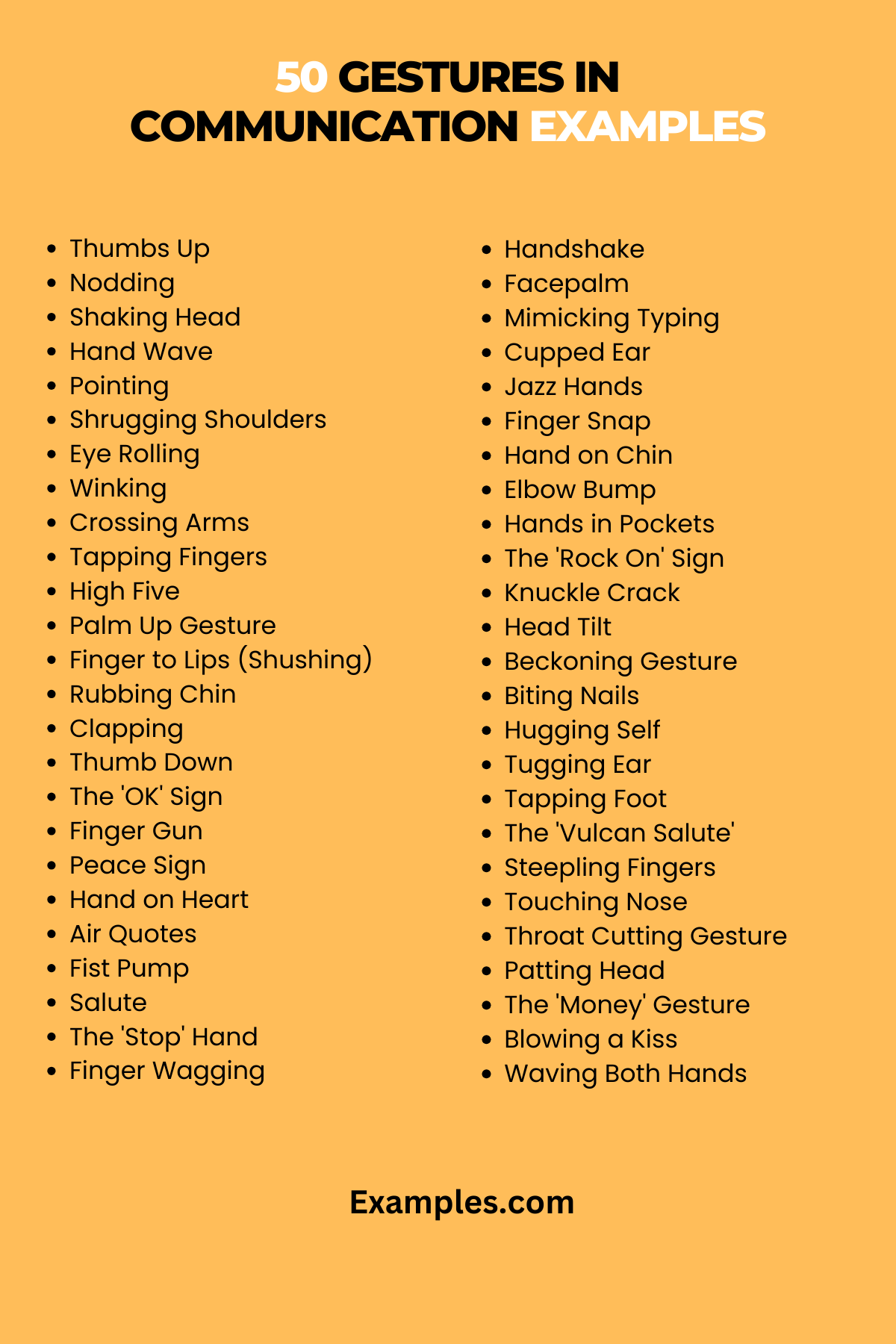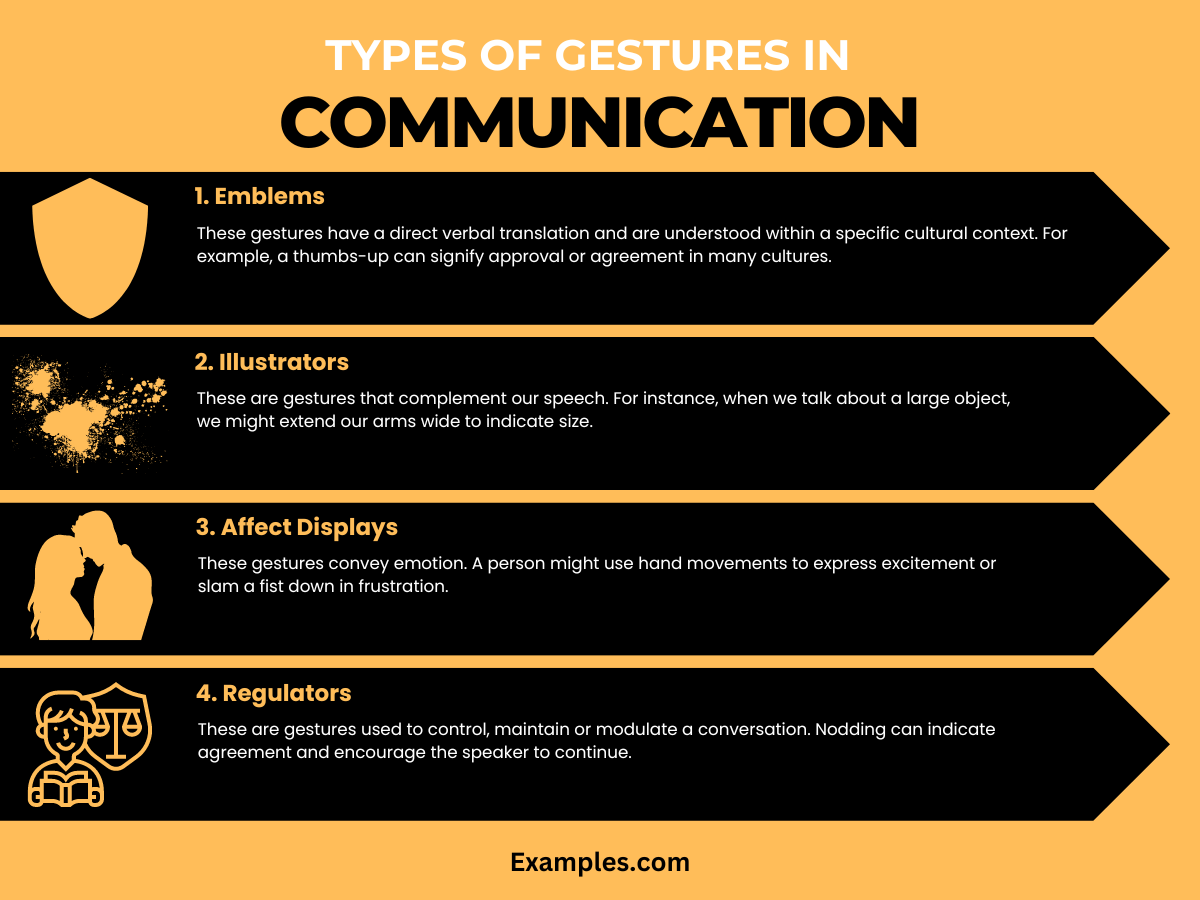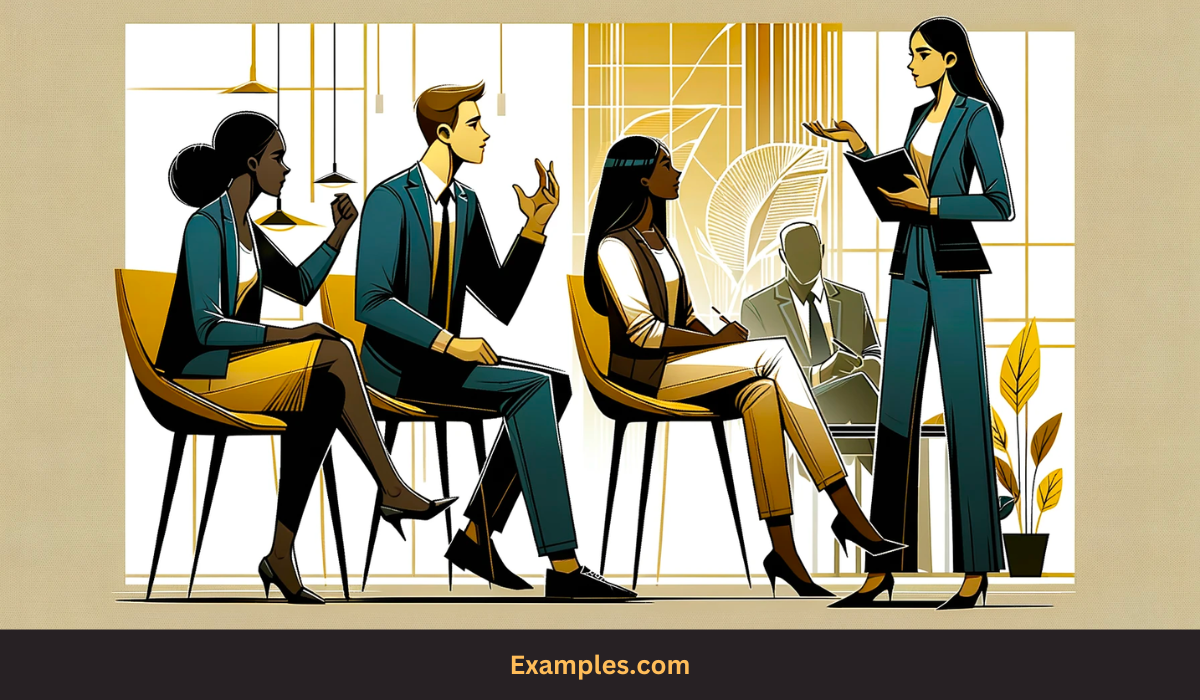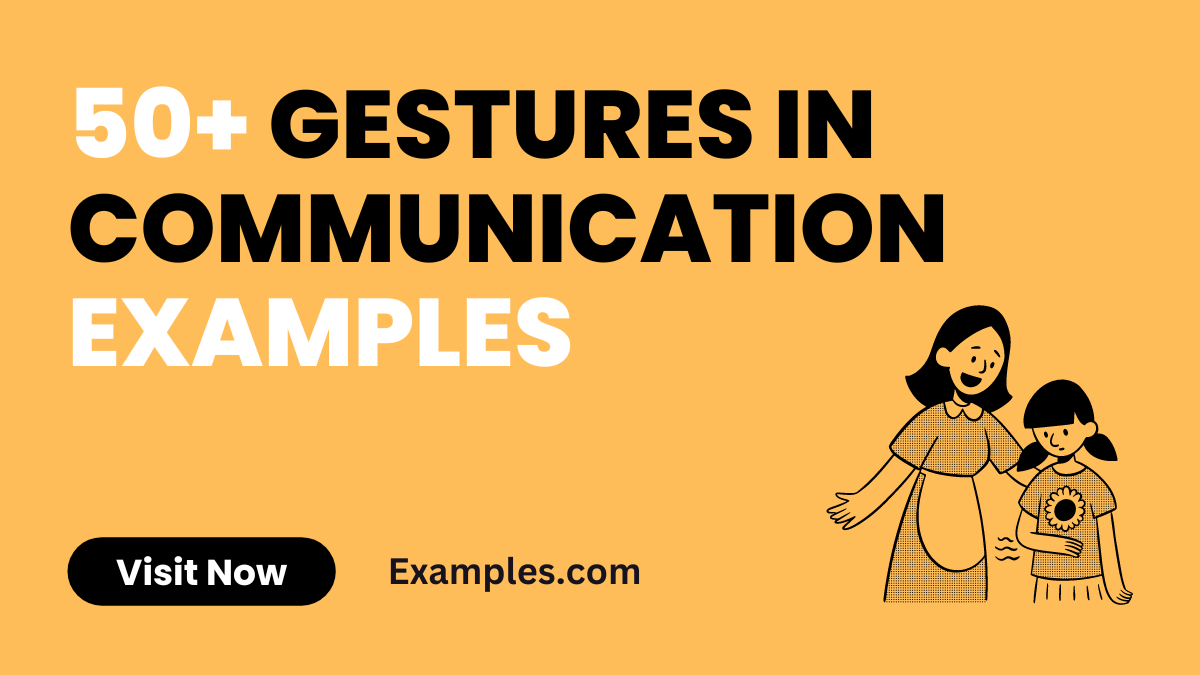49+ Gestures in Communication Examples
In the realm of effective communication, gestures play a pivotal role, often speaking louder than words. Our comprehensive guide delves into the nuanced world of nonverbal cues, offering a plethora of communication examples that illustrate how gestures can profoundly impact interactions. From subtle hand movements to expressive body language, this guide provides valuable insights into understanding and harnessing the power of gestures in various communication scenarios. Whether you’re a professional, educator, or student, these examples serve as a practical toolkit for enhancing your communicative abilities.
What are Gestures in Communication? – Definition
Gestures in communication are essential nonverbal cues that consist of body movements, often involving the hands, face, or other body parts, to convey messages without spoken words. These gestures range from simple nods, which are common examples of communication styles, to complex hand signals, reflecting diverse communication examples across cultures. They serve as integral components in both interpersonal communication examples and group interactions, aiding in conveying emotions, reinforcing verbal messages, and even overcoming language barriers in intercultural communication examples. Gestures are not just additive elements but are often central in the communication process example, demonstrating the rich tapestry of human expression beyond words.
What is the best Example of Gestures in Communication?
The thumbs-up gesture stands as a prominent example of gestures in communication, symbolizing agreement, approval, or well-being. This gesture transcends verbal communication examples, offering a universally understood symbol that replaces or reinforces spoken words. It exemplifies the effectiveness of nonverbal cues in various contexts, from casual interpersonal interactions to more formal business communication examples. The thumbs-up gesture encapsulates the essence of gestures in communication skills, showcasing how a simple, yet powerful nonverbal cue can convey complex messages, bridge communication barriers examples, and enhance understanding in both personal and professional settings.
50 Gestures in Communication Examples

Gestures in communication are a vital element of nonverbal interaction, often providing deeper insight than spoken words. This collection of 50 gestures, complete with explanations and example sentences, serves as a practical guide for anyone looking to enhance their communication skills. These examples cover a wide range of expressions, from hand gestures to facial cues, essential in both personal and professional settings.
- Thumbs Up: Signifies approval or agreement.
Example: When asked if he liked the idea, he gave a thumbs up. - Nodding: Indicates understanding or agreement.
Example: She nodded to show she was following the conversation. - Shaking Head: Expresses disagreement or disapproval.
Example: He shook his head when he heard the incorrect answer. - Hand Wave: A gesture of greeting or farewell.
Example: She waved at her neighbor across the street. - Pointing: Used to direct attention towards an object or direction.
Example: He pointed to the exit sign when asked for directions. - Shrugging Shoulders: Shows uncertainty or ignorance.
Example: When asked about the schedule, she just shrugged her shoulders. - Eye Rolling: Demonstrates disbelief or annoyance.
Example: She rolled her eyes at the over-the-top story. - Winking: Implies playfulness or inside knowledge.
Example: He winked to indicate he was just joking. - Crossing Arms: Often indicates defensiveness or self-protection.
Example: He crossed his arms while waiting in the cold. - Tapping Fingers: Signals impatience or boredom.
Example: She tapped her fingers on the table during the long wait. - High Five: Signifies celebration or agreement.
Example: They high-fived each other after successfully completing the project. - Palm Up Gesture: Indicates openness or honesty.
Example: He spoke with his palms up, showing his sincerity. - Finger to Lips (Shushing): Requests silence or secrecy.
Example: She put her finger to her lips to signal the room to be quiet. - Rubbing Chin: Implies deep thinking or uncertainty.
Example: He rubbed his chin while pondering the question. - Clapping: Shows appreciation or agreement.
Example: The audience clapped enthusiastically after the performance. - Thumb Down: Expresses disapproval or rejection.
Example: She gave a thumbs down to the proposal. - The ‘OK’ Sign: Indicates that everything is fine.
Example: He gave an ‘OK’ sign to show that the plan was going well. - Finger Gun: Suggests playfulness or acknowledgement.
Example: He pointed finger guns as a playful greeting. - Peace Sign: Symbolizes peace or victory.
Example: She flashed a peace sign during the photo. - Hand on Heart: Shows sincerity or pledge.
Example: He placed his hand on his heart while making the promise. - Air Quotes: Implies sarcasm or irony.
Example: He used air quotes while referring to the so-called ‘easy’ task. - Fist Pump: Expresses excitement or support.
Example: She did a fist pump when she heard the good news. - Salute: Shows respect or acknowledgment.
Example: The soldier saluted as the flag was raised. - The ‘Stop’ Hand: Signals to halt or refuse.
Example: She raised her hand in a ‘stop’ gesture to end the conversation. - Finger Wagging: Implies disapproval or warning.
Example: The teacher wagged her finger at the misbehaving student. - Handshake: Indicates agreement or introduction.
Example: They sealed the deal with a firm handshake. - Facepalm: Shows frustration or embarrassment.
Example: He did a facepalm when he realized his mistake. - Mimicking Typing: Suggests writing or working.
Example: She mimicked typing to show she was busy with her report. - Cupped Ear: Indicates listening or request for repetition.
Example: He cupped his ear, indicating he couldn’t hear the speaker. - Jazz Hands: Expresses excitement or flamboyance.
Example: She showed her excitement with a display of jazz hands. - Finger Snap: Suggests a quick moment or attention-grabbing.
Example: He snapped his fingers to recall the sudden idea. - Hand on Chin: Indicates contemplation or judgment.
Example: She rested her hand on her chin while evaluating the artwork. - Elbow Bump: A friendly, touch-free greeting.
Example: They greeted each other with an elbow bump. - Hands in Pockets: Can imply casualness or discomfort.
Example: He put his hands in his pockets, appearing relaxed. - The ‘Rock On’ Sign: Symbolizes fun or approval in music contexts.
Example: He flashed the ‘rock on’ sign at the concert. - Knuckle Crack: Prepares for action or relieves tension.
Example: He cracked his knuckles before starting the task. - Head Tilt: Shows curiosity or empathy.
Example: She tilted her head while listening attentively. - Beckoning Gesture: Invites someone closer or to follow.
Example: The guide beckoned the tourists to follow him. - Biting Nails: Indicates nervousness or anxiety.
Example: She bit her nails while waiting for the results. - Hugging Self: Implies self-comfort or coldness.
Example: He hugged himself to keep warm in the chilly weather. - Tugging Ear: Signifies indecision or wanting to interject.
Example: He tugged his ear while trying to decide his answer. - Tapping Foot: Indicates impatience or eagerness.
Example: She tapped her foot impatiently during the long wait. - The ‘Vulcan Salute’: A gesture of greeting popularized by science fiction.
Example: He gave a Vulcan salute at the comic convention. - Steepling Fingers: Implies confidence or authority.
Example: The CEO steepled her fingers while discussing the strategy. - Touching Nose: Can suggest doubt or secrecy.
Example: He touched his nose, hinting he might be keeping a secret. - Throat Cutting Gesture: Indicates stopping or refusal.
Example: He made a throat cutting gesture to signal the end of the discussion. - Patting Head: Shows affection or condescension.
Example: She patted the child’s head after his performance. - The ‘Money’ Gesture: Suggests wealth or the topic of money.
Example: He rubbed his fingers together talking about potential profits. - Blowing a Kiss: Expresses love or farewell.
Example: She blew a kiss to her family as she boarded the train. - Waving Both Hands: Shows extreme excitement or urgent greeting.
Example: He waved both hands enthusiastically upon seeing his friend.
Examples of Hand Gestures in Communication
Hand gestures in communication are a powerful tool, enhancing the effectiveness of verbal and nonverbal communication examples. These gestures range from simple nods, integral in internal communication examples, to complex hand signals reflecting a diverse array of communication styles examples. Here are five distinct hand gestures used in communication:
- The ‘Come Here’ Gesture: Signifies an invitation or request for someone to approach.
Example: The manager used the ‘come here’ gesture to summon the intern for a discussion. - Palm Facing Outward: Represents a need to stop or a signal of refusal, often seen in crisis communication examples.
Example: The security guard raised his palm outward to halt the crowd. - Thumb and Index Finger Circle: A universal gesture for ‘okay’ or approval, common in both personal and professional communication examples.
Example: The chef made the gesture to show the meal was perfectly cooked. - The ‘Thinker’ Pose: Reflects deep thought or contemplation, a gesture often mirrored in intrapersonal communication examples.
Example: In deep thought, he mimicked the ‘thinker’ pose while considering the proposal. - Fingers Crossed: Symbolizes hope, expectation, or wishing luck, a gesture frequently seen in interpersonal communication examples.
Example: Before the announcement, she crossed her fingers, hoping for a positive outcome.
Examples of Gestures in Nonverbal Communication
Nonverbal communication gestures play a crucial role in enhancing communication objectives examples, transcending the barriers of verbal communication. These gestures are instrumental in expressing emotions and intentions in settings ranging from casual interactions to formal business communication examples. Here are five key nonverbal communication gestures:
- Nodding Slowly: Conveys understanding, agreement, or affirmation, a fundamental aspect in effective communication examples.
Example: The therapist nodded slowly, showing empathy to the client’s situation. - Leaning Forward: Demonstrates active engagement or interest, often emphasized in effective listening and communication strategy examples.
Example: During the negotiation, she leaned forward to express her keen interest in the deal. - Mirroring: Reflecting another person’s posture or gestures, a technique used in persuasive communication and marketing communication examples.
Example: The salesman mirrored the client’s gestures, creating a sense of rapport. - Stroking Chin: Indicates thinking or evaluation, a gesture common in decision-making and technical communication examples.
Example: Contemplating the offer, he stroked his chin, weighing its pros and cons. - The ‘Yawn’ Cover: A polite way to conceal a yawn, reflecting awareness of etiquette in professional communication examples.
Example: In the long meeting, she discreetly covered her mouth while yawning.
Gestures as Examples of Verbal Communication
In verbal communication, gestures serve as powerful tools to reinforce or emphasize spoken words. These gestures are critical in communication styles examples, helping to clarify and enhance the spoken message in both interpersonal and business communication examples. Here are five gestures that commonly accompany verbal communication:
- Counting on Fingers: Aids in listing or emphasizing points during a conversation, a technique seen in clear communication and presentation skills examples.
Example: Outlining the project steps, she counted them on her fingers for clarity. - Quotation Marks in Air: Used to indicate quoting someone or to convey irony, a gesture frequently observed in communication styles examples and storytelling in communication.
Example: He used air quotes to emphasize a ‘groundbreaking’ idea in his speech. - Hand Flapping: Signifies excitement or urgency in speech, commonly seen in enthusiastic communication and public speaking examples.
Example: Animatedly, he flapped his hands while sharing his vacation story. - Tapping on Wristwatch: Indicates time-related concerns or impatience, often observed in time management and professional communication examples.
Example: During the meeting, he tapped his wristwatch, signaling the need to conclude discussions promptly. - Gesturing Upwards: Represents growth, increase, or escalation, a visual aid in communication strategy examples and business presentations.
Example: Discussing company growth, he gestured upwards to represent the rising sales trends.
These gestures enrich the tapestry of communication, providing additional layers of meaning and emphasis to the spoken word in a variety of communicative contexts.
Types of Gestures in Communication

Gestures play a pivotal role in enhancing communication, offering a non-verbal means to express thoughts, emotions, and intentions. They are a vital component of effective communication, often bridging the gap where words fall short. There are several types of gestures commonly used in communication:
- Emblems: These gestures have a direct verbal translation and are understood within a specific cultural context. For example, a thumbs-up can signify approval or agreement in many cultures.
- Illustrators: These are gestures that complement our speech. For instance, when we talk about a large object, we might extend our arms wide to indicate size.
- Affect Displays: These gestures convey emotion. A person might use hand movements to express excitement or slam a fist down in frustration.
- Regulators: These are gestures used to control, maintain or modulate a conversation. Nodding can indicate agreement and encourage the speaker to continue.
- Adaptors: These are often subconscious gestures used to manage emotions. For example, someone might fidget with a pen when nervous.
What is the Importance of Gestures in Communication

Gestures are a fundamental aspect of communication for several reasons:
- Enhancing Verbal Messages: Gestures can add emphasis or clarity to our verbal communication, making it more engaging and effective.
- Conveying Emotion: They are powerful tools for conveying feelings and attitudes, often more effectively than words alone.
- Facilitating Understanding: In intercultural communication, gestures can be pivotal in bridging language barriers, providing non-verbal cues to aid understanding.
- Reflecting Personality: Gestures can also be an expression of one’s personality, revealing traits like enthusiasm, confidence, or nervousness.
- Improving Memory Recall: Engaging in gestures while speaking can improve the speaker’s memory recall and help listeners retain the information better.
- Regulating Interactions: They play a crucial role in the flow of conversations, signaling when it’s another person’s turn to speak or indicating interest or boredom.
Understanding and effectively using gestures can greatly enhance the efficacy of communication in various fields, including business, education, healthcare, and personal relationships. This knowledge is particularly relevant in contexts like marketing communication, team communication, and leadership communication, where clear and impactful communication is vital.
What is the Role of Gestures in Communication

Gestures play a multifaceted role in communication, significantly influencing how messages are conveyed and interpreted. They function as an integral part of our communicative repertoire, enhancing and sometimes even substituting verbal communication. Here are key roles that gestures play:
- Clarifying Verbal Messages: Gestures can clarify or elaborate on what is being said, aiding in reducing miscommunication examples.
- Expressing Unspoken Emotions: They often reveal emotions and attitudes that might not be explicitly stated, thus adding depth to interpersonal communication examples.
- Facilitating Listener Engagement: Engaging gestures capture the listener’s attention, making the communication more dynamic and memorable.
- Substituting Words: In instances of language barriers, gestures can serve as a universal language, aiding in cross-cultural communication examples.
- Aiding Memory: Both speakers and listeners can benefit from gestures, as they can enhance memory retention and recall.
- Regulating Conversations: Gestures are used to signal turns in conversation or to indicate when a point has been understood, vital in team communication and leadership communication.
- Enhancing Persuasiveness: In contexts like marketing communication and public speaking, effective use of gestures can make arguments more persuasive.
What are Gestures in Communication Skills

In the context of communication skills, understanding and utilizing gestures effectively is crucial. Gestures in communication skills encompass:
- Non-Verbal Expressiveness: The ability to use body language, including hand movements, facial expressions, and posture, to complement and reinforce verbal messages.
- Cultural Sensitivity: Recognizing that gestures can have different meanings in different cultures, an essential skill in global communication and intercultural communication examples.
- Active Listening: Part of active listening includes being aware of and responding to the non-verbal cues of others, a key component in effective communication examples.
- Adaptability: The capacity to modify gestures to suit different communication contexts, such as formal settings like corporate communication or more casual scenarios like informal communication examples.
- Empathy: Using gestures to show understanding and empathy, especially in sensitive contexts like health communication or conflict resolution communication.
- Clarity and Consistency: Ensuring that gestures match the verbal message to avoid confusion, particularly important in professional communication examples and technical communication examples.
Incorporating gestures into communication skills enhances the overall effectiveness of interactions, whether in personal relationships, educational settings, or professional environments.
In conclusion, understanding and effectively utilizing gestures in communication is vital for clarity, emotional expression, and audience engagement. This guide has highlighted the types, roles, and importance of gestures, offering practical tips for integrating them into various communication contexts. Mastering this aspect of non-verbal communication can significantly enhance interpersonal and professional interactions.



